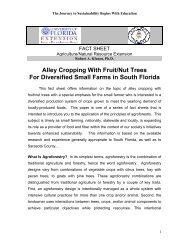RAIN BARRELS - Sarasota County Extension
RAIN BARRELS - Sarasota County Extension
RAIN BARRELS - Sarasota County Extension
You also want an ePaper? Increase the reach of your titles
YUMPU automatically turns print PDFs into web optimized ePapers that Google loves.
<strong>RAIN</strong> <strong>BARRELS</strong>A HOMEOWNER’S GUIDE
TABLE OF CONTENTSIntroduction. . . . . . . . . . . . . . . . . . . . . . . . . . . . . . . . . . . . . . . . . . . . . . . . .5Benefits of a Rain Barrel . . . . . . . . . . . . . . . . . . . . . . . . . . . . . . . . . . . . . .6Components of a Rainwater Collection System . . . . . . . . . . . . . . . . . . .7How Much Rainwater Can I Collect? . . . . . . . . . . . . . . . . . . . . . . . . . .11Rain Barrel Construction. . . . . . . . . . . . . . . . . . . . . . . . . . . . . . . . . . . . .12Overflows and Multiple Barrels . . . . . . . . . . . . . . . . . . . . . . . . . . . . . . .17Uses for Collected Water . . . . . . . . . . . . . . . . . . . . . . . . . . . . . . . . . . . . .19Examples of Cisterns and Rain Barrels . . . . . . . . . . . . . . . . . . . . . . . . .20Painting Your Rain Barrel . . . . . . . . . . . . . . . . . . . . . . . . . . . . . . . . . . . .22Frequently Asked Questions . . . . . . . . . . . . . . . . . . . . . . . . . . . . . . . . . .23Resources. . . . . . . . . . . . . . . . . . . . . . . . . . . . . . . . . . . . . . . . . . . . . . . . . .25Contact Information. . . . . . . . . . . . . . . . . . . . . . . . . . . . . . . . . . . . . . . . .26Writing and Photography byGerard WatsonHillsborough <strong>County</strong> Water DepartmentWater Conservation StaffDesign by Maria Marmol, McShane Communications, Inc.Funding by the Southwest Florida Water Management District3
INTRODUCTIONThis booklet is designed to educatehomeowners on harvesting rainwaterby using a small rain barrel. Harvestingrainwater allows the homeowner tosupplement other irrigation sources at aminimal cost. Storing rainwater also aidsin the reduction of stormwater runoff,which can lead to reduced levels ofpesticides and fertilizers in stormwaterponds, streams, lakes and bays. Asthe region continues to have extendedperiods of below-normal rainfall, havingextra water on hand is a good idea.This booklet focuses only on storingrainwater for non-potable outdoor usesas a supplement to natural rainfall andother sources of irrigation. Rainwaterharvesting for potable uses, such asdrinking, cooking and bathing, ispossible and is done in many parts ofthis country and throughout the world.However, using rainwater for potableuses requires filtration, treatment androutine testing for safety — all topicswhich are beyond the scope of thistext. This booklet covers only simplecollection and distribution methodsrelated to landscape watering.Cisterns and rain barrels have beenaround for thousands of years and thetime has come for more homeowners toenjoy their benefits.Multiple barrels provide forgreater water storage.5
BENEFITS OF A <strong>RAIN</strong> BARRELRainwater harvesting is alwaysbeneficial, whether the water is usedto water one houseplant or an entiregarden. Also, the act of collectingrainwater can be an inspiration to findother ways to conserve water around thehome.When designing a cistern or rain barrel,you want it to be as large as yourbudget and location will allow. Manyhomeowners are making rain barrelsout of 50- to 55-gallon food-gradedrums that were used to carry foodproducts, such as juices, olives, pickles,etc. Containers or drumsunder 300 gallons are affordable,readily available at most drumor barrel suppliers and are smallenough to fit on most residential orcommercial lots.Although a small rain barrel may notprovide all the water needed to sustainyour plant material, it can certainlysupplement your current wateringschedule. Planter beds, vegetable orflower gardens and potted plants caneasily be irrigated with the water from arain barrel.Rain barrels are one componentof this water-efficient landscape.The water savings from using storedrainwater rather than municipal orwell water can be substantial over aperiod of time. A rain barrel can alsohelp reduce the amount of water thatmay settle around the foundation ofyour home.6
Whether you install a large concretecistern or a small plastic rain barrel, thefollowing basic components are involvedin every rainwater collection system:1. Catchment Area2. Conveyance System3. Storage Tank4. Filtration5. Water DistributionCOMPONENTS OF A <strong>RAIN</strong>WATERCOLLECTION SYSTEM1. Catchment AreaA catchment area can be any area thatcollects or sheds rainwater. A roof isthe most common and adaptable areato use for rainwater collection. Due toits already existing slope and height, aroof makes a perfect catchment area byusing gravity to direct the water. Mosthomes and commercial buildings areequipped with a guttering system thatcan easily be adapted to funnel waterto a storage tank. If guttering does notexist, it can be added to the side of thehouse or building that will be used forrainwater collection. This can be done ata relatively low cost.A roof makesa perfectcatchment area.Other forms of catchment areas mayinclude sidewalks, driveways andnatural or man-made swales or berms inthe landscape that can direct the flow ofrainwater to a storage tank.7
2. Conveyance SystemOnce the catchment area has beenidentified, the next step is to transportthat water into the storage tank. With aroof catchment area, a guttering systemis the easiest. All this may require ismodifying the existing guttering systemto divert the downspouts into thestorage tank. Remember to keep anygutter or downspout modificationssloping downward toward the storagetank. Large diameter PVC pipe, rubberhose or tubing can also be used.3. Storage TankA storage tank can be made of variousmaterials and can be located above orbelow ground. Some materials used forstorage tank construction are plastic,fiberglass, concrete and metal. So waterwill not leak out, the material shouldbe smooth and nonporous. Storagetanks can be elaborate concretestructures or simple plastic containerslike garbage cans or barrels.Most storage tanks are placed aboveground to take advantage of the force ofgravity. A below-ground tank requires apump to get the water out. Thisincreases the cost and maintenance ofthe system.Gutters and downspouts funnelrainwater to the rain barrels.Some common containers used for rainbarrels are (left to right): 50-gallonsealed barrel, 275-gallon juice container,50-gallon open-top barrel.8
4. FiltrationGenerally, rainwater does not need tobe filtered for outdoor use. As watersheds off a roof or other catchmentarea, it may pick up leaf debris, birddroppings or chemical agents from theroof material, but these are not harmfulto plants. A simple screen mesh, suchas window screen or wire mesh, tokeep out leaf debris and insects is allthe filtration that is needed. This canbe placed where the water enters theconveyance system (guttering) or justbefore the storage tank (downspouts ortank opening).Although a screen will keep out mostdebris, a small amount of debris will getinto the storage tank. It is a good ideato clean the tank periodically to avoid alarge buildup of debris on the bottom.If using a submersible pump inside thestorage tank, a filter will be requiredto keep the pump from clogging. Thepump should come with its own filteror screen, or with instructions on howto make one. The filter may requireroutine maintenance, so easy access tothe pump will be a necessity.A window screen placed over the barrel opening (left) or a gutterstrainer placed in the downspout opening (right) will keep leavesand other debris out of the rain barrel.9
5. Water DistributionGetting the water to your plants is thefinal step of the rainwater collectionsystem. Due to low water pressure frommost rain barrel applications, waterdistribution will be limited to a wateringcan, soaker hose or garden hose.Water pressure at the tank outletdirectly depends on the height or levelof the water that is stored in the tank,so water pressure will vary. The higherthe water level in the tank, the greaterthe water pressure will be. Elevating thetank on a platform, such as cinderblocks, can generate a small increase inpressure for any attachments hooked upto the outlet. For small storage tanks,water pressure is minimal and notenough to operate most low-volumeirrigation devices. To generate anyworkable pressure without the use of apump, a tall storage tank or anextremely elevated tank is needed.If a large area is to be watered using alarge storage tank, adding a small pumpmay be an option to consider. Installinga pump on a small rain barrel would beimpractical, as the flow rate would drainthe barrel in minutes. Pumps work wellon a large tank, such as the 275-gallonjuice container pictured below. Havingwater pressure of 10–25 pounds persquare inch and a larger volume ofwater can sustain most low-volumeirrigation devices such as inline driptubing, mist sprays or drip emitters.Note: It is important to keep anyplumbing attachments to your rainbarrel or cistern independent from yourexisting house piping or sprinklersystem piping. This will prevent a crossconnectionto your potable water.A small submersible pump could be placedinside this 275-gallon juice container.Using a timer on the pump’s power cordcould allow you to establish an automaticcustomized watering schedule.10
HOW MUCH <strong>RAIN</strong>WATERCAN I COLLECT?For a general calculation, you can collectabout a half gallon of water per squarefoot of roof area during a 1-inch rainfall.As an example, a house with a 2,000-square-foot roof can collect about 1,000gallons of water (the actual amount of rainthat falls on your roof is about 20 percent more,but some is lost to evaporation, runoff andsplashing). This is a substantial amount ofwater, and a large cistern would beneeded to collect all of it. To calculateyour volume of water, use only thatportion of the roof or catchment areathat is actually feeding your storage tank.To get a more accurate figure on thegallons collected, you would have to takethe slope of the roof into account. A roofwith a steep slope would collect lessrainwater than a flatter roof, even if theyboth have the same square foot area.As you can see, it doesn’t take muchrain to fill a small rain barrel. A typical1/2-inch rainfall event will fill a 50- to 55-gallon barrel. It is a good idea to add anoverflow outlet/pipe near the top of thebarrel. This will divert any excess waterto another part of the yard, which canreduce the amount of water that settlesaround the foundation of your house.To store even more rainwater, multiplerain barrels can be linked together withhard PVC or flexible hose. Although youcan use small diameter pipe or even agarden hose, large diameter pipe ortubing (1.5"–2") will be able to carrymore rainwater during a heavythunderstorm and will prevent waterfrom possibly backing up the downspout.Steps to connect an overflow outlet andlink barrels together are covered later inthis booklet.Connecting rain barrels together will allow for more water collection.11
<strong>RAIN</strong> BARREL CONSTRUCTIONFirst decide where to place the storagetank. This, along with your budget, willdetermine the size of the storage tank.Remember, try to obtain the largesttank the location will allow. This willenable you to do more things with thewater by having more water volumeand possibly more water pressure.When choosing a location, you shouldkeep in mind how the water is going toget from your catchment area to thestorage tank. Most rain barrels will beplaced adjacent to the home to tie intoexisting downspouts. Placing yourstorage tank closer to the area you wantto water, such as your garden or planterbed, may provide easier access to thewater, but may be impractical if longlengths of piping are needed to get thewater to the storage tank.If you do not have gutters and do notwant to add them to the house, the rainbarrel can be placed directly under anarea of the roof that sheds a lot of water(such as a valley in the roof). In thiscase, a screen can be placed over thebarrel to keep out debris, small animalsand insects. This type of barrel can alsobe placed in any part of the yard tocollect falling rain. It will take a lotlonger to fill, but may be more practicalif the area you want to water is a gooddistance from your house.Elevating the rain barrel on a platform,such as cinder blocks, will giveadditional water pressure and willprovide clearance for connecting a hoseor filling a watering can.12A barrel covered with window screen can be placedunder a roof valley to collect rainwater runoff.A good spot for a rain barrel.
ASSEMBLY ANDINSTALLATION STEPSThe following are basic steps on how toinstall a rain barrel or similar storagetank on your property. All rain barrelsor cisterns, regardless of size, will havean inlet for the water (usually a gutterdownspout or similar piping) and anoutlet (hose spigot, valve, bulkheadfitting, etc.).Step 1. Clean the rain barrelBe sure to select only food-qualitycontainers. Do not use containers thatheld harsh chemicals. Before installingyour rain barrel, take a few minutes torinse the inside of the barrel. Manybarrels have food or juice remnants thatshould be removed before using it tostore water. Use a mixture of 1 /8 cup ofbleach and 5 gallons of water as acleaning solution.Use 1 /8 cup of bleach mixedwith 5 gallons of waterto clean the rain barrel.Thoroughly rinse out thebarrel before using.13
Step 2. Install the outlet(hose spigot)In this application, we are going toinstall a 3 /4" hose spigot. For this youwill need to drill a 15 /16" hole for thespigot threading. Drill the hole a fewinches (4"–6") from the bottom of the1barrel. This will provide a few inches ofclearance for attaching a hose or fillinga watering can. This also allows roomfor debris that enters the barrel, such asleaves, to settle below the level of theoutlet, which prevents clogging.32First, drill hole nearbottom of barrel.When the spigot is in about half way, apply aliberal amount of PVC cement to the exposedthreads. Continue to screw in the spigot until it issnug and pointing toward the bottom of the barrel.4Next, screw in the hose spigotabout halfway. Make sure thethreading is going in straight,as this will help prevent leaking.The rain barrel outlet is now complete.14
Step 3. Build aplatform for thebarrelConcrete cinderblocks provide astrong, stableplatform for yourCinderblock platform rain barrel. If youuse more thanone layer of blocks, stack them in acrisscross pattern so they won’t tip over.Make sure the blocks are level and evenso that the barrel will not lean.Step 4. Connect downspout tobarrelOnce you have your barrel positionedand at its set height, you can measurewhere you need to cut or disconnectyour downspout. In most cases, you candisassemble the downspout at the gutterby taking out screws or drilling outrivets. This will avoid cutting the gutteror downspout. If you do have to make acut, use a fine-toothed hacksaw blade(24 or 32 teeth/inch) or a pair of tinsnips.To make the transition from the gutter/downspout to your opening in the rainbarrel, you can fabricate a crosspieceout of downspout material or purchasea flexible downspout extender. Theflexible downspout extender eliminatesthe need for exact measurementbecause it bends and stretches to thelength you need. Make sure thedownspout extender fits the size ofyour downspout.Mark downspoutfor cutting.DownspoutconnectionsFlexibledownspout extender15
Step 5. Cut barrel openingOnce you have completed yourdownspout connection, place it in thebarrel. If your barrel comes with a lid, orif it has a sealed top, you will need to cuta hole in it.1Start by tracing the outline of thedownspout or pipe that will beentering the barrel.Next, cut out the hole youjust traced. You can use ahandsaw, but a jigsawworks best. Drill holes in eachcorner to provide access for thesaw blade. Cut exactly along yourtrace line, as this will provide anice tight fit for the downspout.23Put the rain barrel in position andplace the downspout into the hole.Your rain barrel is now complete.16
OVERFLOWS ANDMULTIPLE <strong>BARRELS</strong>Now that you have your first rain barrelinstalled, you may want to connect anoverflow pipe or link multiple barrelstogether. An overflow pipe will carryexcess water that would normallyoverflow the barrel to another part ofthe yard or into another rain barrel.Diverting excess water to another partof your yard can be beneficial byreducing the amount of water aroundthe foundation of your house duringa rainstorm.Overflow OutletYou can use PVC pipe, rubber tubingor even a garden hose as an overflow.In this example, we will use 2" PVCpipe as our overflow. Althoughsmaller piping or hose will work,large diameter piping will handleeven the biggest thunderstorms.31We first start by drillinga 2 1 /4" hole forthe 2" male adapter.Since this is an overflow,it will have to be nearthe top of the barrel.A 90-degree elbow and a lengthof 2" PVC pipe are added to carrythe water away from the houseto a nearby planter bed.2The 2" maleadapter is screwedin to make thetransition to ouroverflow pipe.PVC cement is generally not neededbecause the pieces should fit tightlytogether and a little leakage is okay.It also makes it easier to disassemblethe pieces for cleaning or maintenance,if necessary.17
Linking MultipleBarrels TogetherThere are various methods you can useto connect rain barrels. The process issimilar to making the overflow outlet,but your pipe or hose will lead toanother barrel instead of another part ofthe yard. The connections betweenbarrels can be made at the top or at thebottom. Follow the steps for adding theoverflow outlet and make theconnections with the piping or tubing ofyour choice. You can link as manybarrels together as space allows. It is stilla good idea to put in an overflow pipeon the last barrel.If you make the connections at the top,you will need to have an outlet on eachbarrel. Once the water level dropsbelow the connection pipe, there will beno other way for the water to drain outof the barrel without an additionaloutlet. If the connection is made at thebottom, only one barrel will need anoutlet because the water level in theconnected barrels will drop equally aswater is let out. For bottom connections,an outlet can also be placed in the pipeor tubing connecting the barrels, insteadof the barrels themselves.Types of connections:flexible hose clampedon PVC fittings(top left), gardenhose (top right), 2"PVC pipe connectedat bottom of barrels(bottom left), 2" PVCpipe connected at top ofbarrels (bottom right).18
USES FOR COLLECTED WATERIf you currently have a standardirrigation system, you may be able toturn off sprinkler zones that are inplanter beds or gardens and usestored rainwater instead.The low water pressure generated froma small rain barrel is not adequate tooperate any type of in-ground sprinkleror low-volume devices, such as mistsprays or inline drip tubing. However, asoaker hose or a length of PVC pipe orgarden hose with holes punched in itmay work with these low pressures.If using a soaker hose, take out thepressure-reducing washer to allow morewater to flow through the hose (bottomright). Filling a watering can to waterplants around the yard is always anoption. You can also use the water tokeep your compost bin moist or to rinseoff gardening tools.Hand waterplants.Use to keepcompost bin moist.Attach asoaker hoseto waternearbyplants.Remove the pressurereducingwasher fromthe soaker hose.19
EXAMPLES OF CISTERNSAND <strong>RAIN</strong> <strong>BARRELS</strong>In 1996, a 15,000-gallon cistern wasconstructed at Hillsborough <strong>County</strong>’smain courthouse. This project wasapproved by the Board of <strong>County</strong>Commissioners, with cooperativefunding provided by the SouthwestFlorida Water Management District.This cistern demonstration project isnamed “Hydria,” the Greek word forwater jar. Rainwater is collected fromthe courthouse roof and is stored in anunderground tank. Water-using items,such as garden hoses, spigots andwatering cans are in the base of thecistern. This cistern was designed tosupply water to the surroundinglandscape.The Florida House Learning Center in<strong>Sarasota</strong>, Florida, has two cisterns thateach hold 2,500 gallons of rainwater.“Hydria”cisternOne cistern is used for irrigation, theother for irrigation and flushing toilets.The cisterns are one component of theFlorida House’s public education effortsthat teach about water and energyconservation, recycling principles andproducts, and healthy house concepts,including least toxic building materials.Contact information is at the back ofthis booklet.These cisterns at the Florida House Learning Centereach hold 2,500 gallons of rainwater.20
Hillsborough<strong>County</strong> <strong>Extension</strong>Service has ademonstrationrain barrel.Many county extension services haverain barrel demonstration exhibitswhere you can see examples of rainbarrels that any homeowner can install.The extension services also provide anabundance of information on plants,gardening, composting and waterconservation. Most county extensionservices offer workshops on all of thesesubjects.Rain barrels may be painted toincrease their aesthetic value.21
PAINTING YOUR <strong>RAIN</strong> BARRELWhen it comes to being creative, you’reonly limited by your imagination!Painting your rain barrel is not only fun,but it will also help to protect the surfaceof the barrel from breaking down due tothe harsh effects of the sun. Painting arain barrel is a great activity for childrenand can introduce them to theimportance of conserving water.Outdoor acrylics and spray paint workwell, but the barrel must first be primedso these materials adhere properly to thesurface. A product on the market is aspray paint designed specifically foroutdoor plastic furniture, but it willwork on almost any plastic surface. Thebenefit to this product is that the barreldoes not have to be primed beforeapplying the spray paint. If using spraypaint but need to paint small details,spray paint into a small cup makinga liquid puddle. This paint can bebrushed on.Regardless of what type of paint youchoose, it is a good idea to apply one ortwo coats of polyurethane to yourfinished barrel to protect it.To prime your barrel:1. Thoroughly clean the exterior surfaceof the barrel by wiping away excessdirt and grime with a clean rag soakedin a 1:1 mixture of vinegar and water.2. Using a fine- to medium-gradesandpaper, “rough up” the surface ofthe barrel. This helps the paint adhereto the plastic barrel.3. With a dry cloth, wipe the barrelagain to get rid of any fine plasticshavings.4. Apply one coat of outdoor primer.Primer is typically white, but it can bemixed with another paint color ortinted to match the final design colorof the barrel. Allow the primer to dryaccording to the directions on thecontainer.22This barrelwas paintedto match thehouse color.Now the barrel can be painted any wayyou like — by stencil, a pattern,freehand, etc. Allow the paint to drycompletely before applying one to twocoats of polyurethane. Allow thepolyurethane to dry between coats.
FREQUENTLY ASKED QUESTIONSDo I need a permit?Check with your county to see if apermit is required to install a smallrain barrel on your property for nonpotableuses, such as landscapewatering. If you live in an area orsubdivision with deed restrictions, youshould review them before installing arain barrel in your yard. Some deedrestrictions do prohibit them. Youcan also check your local plumbing orhealth codes for guidance.When constructing a large cistern,either above or below ground, checkwith your local plumbing, building andhealth departments to see if a permit orbackflow protection device is requiredor if there are recommended guidelines.Important Note: Rain barrels orcisterns should not in any way beconnected to your in-house plumbing.This will prevent a cross-connection toyour potable water.If you plan on connecting a pump orattaching plumbing or irrigation lines toyour rain barrel or cistern, contact yourlocal plumbing or building department.A backflow protection device may berequired on the potable water service linein these situations. Stored rainwater is notpotable water and should not be used fordrinking, bathing, pets or recreation.What about water quality?The quality of rainwater shedding off aroof or gutter system is more thanadequate for plants. In fact, it can bebeneficial due to the lack of chlorineand a lower pH level than utilityprovidedwater. As rainwater sheds off aroof or other catchment area, it cancarry with it some levels of algae,roofing chemicals or bird droppings.These are not a concern for non-potableuses or occasional contact by thehomeowner.23
Is maintenance required with my rainbarrel?If your rain barrel is properly installed, itshould require very little maintenance.Periodic inspection of the tank for cracksor buildup of debris on the bottom maybe all that is needed. Some barrels,especially light-colored or clear ones thatare in direct sunlight, may become brittleover time. They can be painted to makethem last longer.If you have placed a screen in thedownspout or over the barrel opening,this will require periodic inspection andcleaning to ensure a good water flow.What about mosquitoes?Mosquitoes and other insects are alwaysattracted to standing water. If you have atight fit where the downspout enters thebarrel, there should be little problemswith mosquitoes getting into the barrel.Small gaps or holes can be filled withcaulk or covered with window screen.Also, make sure the guttering is slopedproperly and free of debris to preventstanding water where mosquitoes canbreed. If keeping mosquitoes out of thetank is impossible, there are productsavailable at home centers or pond supplystores that will prevent mosquitoes frombreeding. The most common product isfound in tablet form which containsbacillus thuringiensis, a biologicallarvicide. Just a small amount in thebarrel will last 30 days or longer.Having atight fit where thewater enters thebarrel will keepout mosquitoes.Will my rain barrel tip over?Water weighs a little over 8 lbs. pergallon, so a 50-gallon rain barrel willweigh over 400 pounds when full. If youhave small children or pets, and areconcerned that the barrel might tip over,you may want to strap or attach thebarrel to a nearby wall or other stablestructure (fence, tree, etc.). Any type offrame can be built around the barrel, orstraps can be wrapped around or screwedto the barrel and then anchored to a wallor other stable structure. If the barrel sitson a level and stable platform, tippingover is not a problem.24
RESOURCESRain Barrel SuppliesTo find barrels or drums to convert intorain barrels, look in the Yellow Pagesunder drums, barrels or containers. Atyour local drum supplier, there areseveral types of drums and barrels thatcan easily be converted into a rainbarrel. Make sure you purchase plasticfood-grade containers. Local plumbingsuppliers or home centers will sell all thenecessary fittings such as spigots, PVCadapters and piping to finish theassembly.There are companies that sell preconstructedrain barrels. These preassembled“kits” come with the inletand outlet already installed. They willalso carry the necessary tubing forconnecting barrels together. If youcannot find one locally, check theInternet for a supplier. The Internet isalso a good resource to find anabundance of information aboutrainwater harvesting, rain barrels,cisterns and suppliers.This barrel supplier hashundreds of barrels in varying sizesavailable to the public.25
CONTACT INFORMATIONYour county extension service can provide more information on rain barrels andwater conservation. For contact information, look under your county’s telephonebook listing or visit www.ifas.ufl.edu/extension/cesmap.htm.For more information on water conservation,contact any of the following agencies:Southwest FloridaWater Management District2379 Broad StreetBrooksville, FL 346041-800-423-1476 (FL only) or(352) 796-7211, ext. 4757WaterMatters.orgFlorida House Learning Center4600 Beneva Road South<strong>Sarasota</strong>, FL 34233(941) 316-1200sarasota.extension.ufl.eduSpecial thanks to:Hillsborough <strong>County</strong> <strong>Extension</strong> Service:Marina Pryce, Florida Yards & Neighborhoods CoordinatorBillie Lofland, Senior Television Producer/DirectorTR Drum in Plant City, Florida, for the use of their facilitiesRain barrel artwork done by Cindy Paulhus, Master Gardener26
NOTESMake your own notations as you build your water storage system:<strong>RAIN</strong> <strong>BARRELS</strong>A HOMEOWNER’S GUIDEA free companion video for this booklet is also available.Telephone or mail your request to:Water Conservation StaffHillsborough <strong>County</strong> Water Department925 E. Twiggs St., Tampa, FL 33602(813) 272-5977orSouthwest Florida Water Management District2379 Broad Street, Brooksville, FL 346041-800-423-1476 (FL only), ext. 475727
















